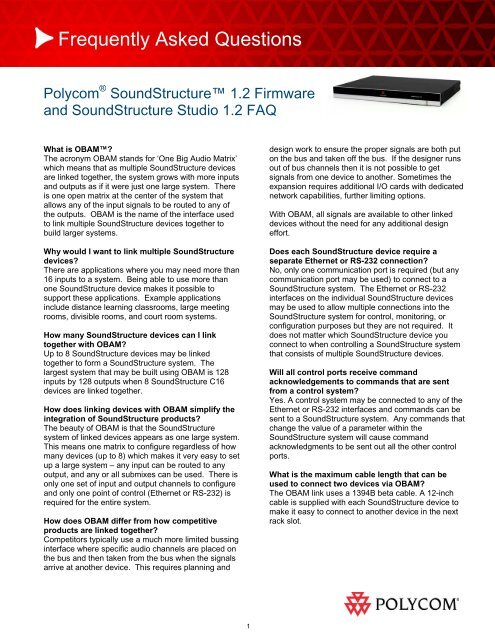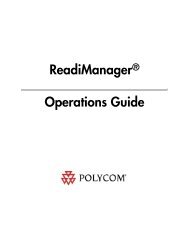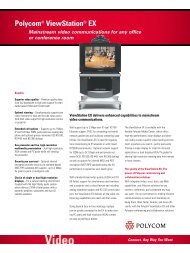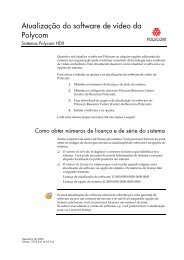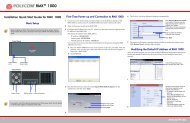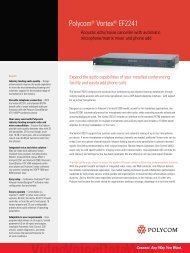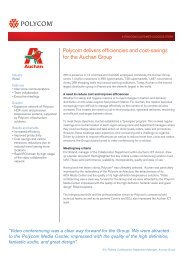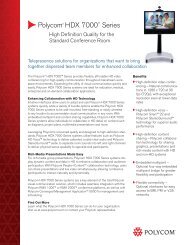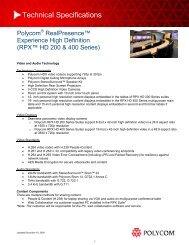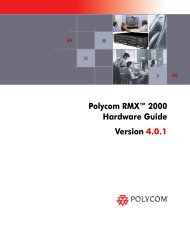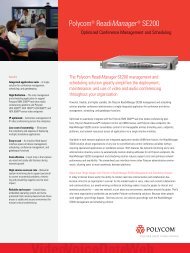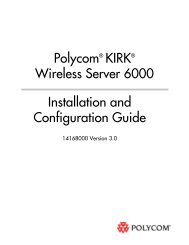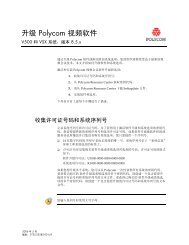SoundStructure 1.2 FAQ - Polycom
SoundStructure 1.2 FAQ - Polycom
SoundStructure 1.2 FAQ - Polycom
You also want an ePaper? Increase the reach of your titles
YUMPU automatically turns print PDFs into web optimized ePapers that Google loves.
Frequently Asked Questions<br />
<strong>Polycom</strong> ® <strong>SoundStructure</strong> <strong>1.2</strong> Firmware<br />
and <strong>SoundStructure</strong> Studio <strong>1.2</strong> <strong>FAQ</strong><br />
What is OBAM?<br />
The acronym OBAM stands for ‘One Big Audio Matrix’<br />
which means that as multiple <strong>SoundStructure</strong> devices<br />
are linked together, the system grows with more inputs<br />
and outputs as if it were just one large system. There<br />
is one open matrix at the center of the system that<br />
allows any of the input signals to be routed to any of<br />
the outputs. OBAM is the name of the interface used<br />
to link multiple <strong>SoundStructure</strong> devices together to<br />
build larger systems.<br />
Why would I want to link multiple <strong>SoundStructure</strong><br />
devices?<br />
There are applications where you may need more than<br />
16 inputs to a system. Being able to use more than<br />
one <strong>SoundStructure</strong> device makes it possible to<br />
support these applications. Example applications<br />
include distance learning classrooms, large meeting<br />
rooms, divisible rooms, and court room systems.<br />
How many <strong>SoundStructure</strong> devices can I link<br />
together with OBAM?<br />
Up to 8 <strong>SoundStructure</strong> devices may be linked<br />
together to form a <strong>SoundStructure</strong> system. The<br />
largest system that may be built using OBAM is 128<br />
inputs by 128 outputs when 8 <strong>SoundStructure</strong> C16<br />
devices are linked together.<br />
How does linking devices with OBAM simplify the<br />
integration of <strong>SoundStructure</strong> products?<br />
The beauty of OBAM is that the <strong>SoundStructure</strong><br />
system of linked devices appears as one large system.<br />
This means one matrix to configure regardless of how<br />
many devices (up to 8) which makes it very easy to set<br />
up a large system – any input can be routed to any<br />
output, and any or all submixes can be used. There is<br />
only one set of input and output channels to configure<br />
and only one point of control (Ethernet or RS-232) is<br />
required for the entire system.<br />
How does OBAM differ from how competitive<br />
products are linked together?<br />
Competitors typically use a much more limited bussing<br />
interface where specific audio channels are placed on<br />
the bus and then taken from the bus when the signals<br />
arrive at another device. This requires planning and<br />
1<br />
design work to ensure the proper signals are both put<br />
on the bus and taken off the bus. If the designer runs<br />
out of bus channels then it is not possible to get<br />
signals from one device to another. Sometimes the<br />
expansion requires additional I/O cards with dedicated<br />
network capabilities, further limiting options.<br />
With OBAM, all signals are available to other linked<br />
devices without the need for any additional design<br />
effort.<br />
Does each <strong>SoundStructure</strong> device require a<br />
separate Ethernet or RS-232 connection?<br />
No, only one communication port is required (but any<br />
communication port may be used) to connect to a<br />
<strong>SoundStructure</strong> system. The Ethernet or RS-232<br />
interfaces on the individual <strong>SoundStructure</strong> devices<br />
may be used to allow multiple connections into the<br />
<strong>SoundStructure</strong> system for control, monitoring, or<br />
configuration purposes but they are not required. It<br />
does not matter which <strong>SoundStructure</strong> device you<br />
connect to when controlling a <strong>SoundStructure</strong> system<br />
that consists of multiple <strong>SoundStructure</strong> devices.<br />
Will all control ports receive command<br />
acknowledgements to commands that are sent<br />
from a control system?<br />
Yes. A control system may be connected to any of the<br />
Ethernet or RS-232 interfaces and commands can be<br />
sent to a <strong>SoundStructure</strong> system. Any commands that<br />
change the value of a parameter within the<br />
<strong>SoundStructure</strong> system will cause command<br />
acknowledgments to be sent out all the other control<br />
ports.<br />
What is the maximum cable length that can be<br />
used to connect two devices via OBAM?<br />
The OBAM link uses a 1394B beta cable. A 12-inch<br />
cable is supplied with each <strong>SoundStructure</strong> device to<br />
make it easy to connect to another device in the next<br />
rack slot.
How do I link multiple <strong>SoundStructure</strong> devices<br />
together?<br />
To connect one device to another, connect the OBAM<br />
output from one device to the OBAM input on another<br />
device.<br />
Is the OBAM link hot-swappable?<br />
No, the link is not hot-swappable with the current<br />
release. To link multiple <strong>SoundStructure</strong> devices,<br />
power down the systems, connect the OBAM<br />
connections between devices, and then power up the<br />
system. Once the devices are linked together it is not<br />
common to have to change the connections between<br />
devices.<br />
How do I know the OBAM link is working properly?<br />
There are two status LEDs on the rear panel of the<br />
<strong>SoundStructure</strong> device that indicate the status of the<br />
link. A Solid Green LED on the OBAM Out or OBAM<br />
In connection indicates that a valid link has been<br />
established. From <strong>SoundStructure</strong> Studio, the Wiring<br />
page will show the number of devices that have been<br />
linked together. A flashing green light indicates either<br />
a cable issue or an invalid cabling configuration.<br />
Can I connect C-series with SR12 products<br />
together using the OBAM link?<br />
Yes, you can link the C-series products with the SR12<br />
product to build the right solution for each application.<br />
The SR12 can be used to provide more line level<br />
inputs and line level outputs to a system. The SR12<br />
inputs could be used for program audio or for<br />
microphones that are not used in the conferencing<br />
space – the SR12 inputs do not have any acoustic<br />
echo cancellation processing so microphones that are<br />
used for conferencing should always be plugged into<br />
inputs on the C-series devices.<br />
How many HDX microphones can I use with a<br />
<strong>SoundStructure</strong> system?<br />
Each <strong>SoundStructure</strong> can support up to four HDX<br />
microphones. Each HDX microphone requires three<br />
analog inputs on the <strong>SoundStructure</strong> system. A<br />
<strong>SoundStructure</strong> C8 (with 8 analog inputs) can support<br />
2 HDX microphones, a <strong>SoundStructure</strong> C12 can<br />
support 4 HDX microphones, and a <strong>SoundStructure</strong><br />
C16 can support 4 HDX microphones plus additional<br />
conventional microphones. The largest system would<br />
support 32 HDX microphones with 4 per<br />
<strong>SoundStructure</strong> device.<br />
©2008 <strong>Polycom</strong>, Inc. All rights reserved. <strong>Polycom</strong> and the <strong>Polycom</strong> logo design are registered trademarks of <strong>Polycom</strong>, Inc.<br />
All other trademarks are the property of their respective owners. Information is subject to change without notice.<br />
2<br />
What version of <strong>SoundStructure</strong> Studio and<br />
<strong>SoundStructure</strong> firmware do I need to link multiple<br />
devices together?<br />
Version <strong>1.2</strong> of <strong>SoundStructure</strong> Studio is required to<br />
create projects for multiple <strong>SoundStructure</strong> devices.<br />
Version <strong>1.2</strong> of the <strong>SoundStructure</strong> firmware is required<br />
to be compatible with the project files that are created<br />
by <strong>SoundStructure</strong> Studio.<br />
Can I take an existing design and easily expand it<br />
to support multiple <strong>SoundStructure</strong> devices?<br />
Yes, there is a Project Conversion wizard in<br />
<strong>SoundStructure</strong> Studio <strong>1.2</strong> that makes it easy to grow<br />
or contract a <strong>SoundStructure</strong> configuration file. This<br />
can be done by clicking the Edit Devices button on the<br />
<strong>SoundStructure</strong> Studio Wiring page. Adjust the<br />
equipment as necessary and then if required channels<br />
can be added or removed to fit into the new<br />
<strong>SoundStructure</strong> devices.<br />
Can I use multiple telephony cards in a multidevice<br />
<strong>SoundStructure</strong> system?<br />
Yes, each <strong>SoundStructure</strong> device may have a<br />
telephony card installed. A <strong>SoundStructure</strong> system<br />
that consists of 8 <strong>SoundStructure</strong> devices may have<br />
up to 8 telephony cards. If all those cards are the<br />
<strong>SoundStructure</strong> TEL2 cards then a total of 16 phone<br />
lines can be supported with 8 <strong>SoundStructure</strong> devices.<br />
Where do I get more information on how to design<br />
with multiple <strong>SoundStructure</strong> devices?<br />
The latest <strong>SoundStructure</strong> Design Guide dedicates<br />
chapter 7 to how to link multiple <strong>SoundStructure</strong><br />
devices with OBAM. You may find this chapter by<br />
looking at the help option within the version <strong>1.2</strong><br />
<strong>SoundStructure</strong> Studio.<br />
Can OBAM be used to connect to any devices<br />
other than <strong>SoundStructure</strong>? Are there any other<br />
devices that support the OBAM link?<br />
Currently, OBAM is only used as an interface to<br />
connect multiple <strong>SoundStructure</strong> units together.<br />
Can OBAM be used to connect <strong>SoundStructure</strong> to<br />
HDX?<br />
No, <strong>SoundStructure</strong> connects to HDX codecs via the<br />
CLINK2 connection on the back of both<br />
<strong>SoundStructure</strong> and HDX. This CLINK2 connection is<br />
independent of OBAM, but still affords designers the<br />
flexibility of routing HDX audio to any <strong>SoundStructure</strong><br />
output.


